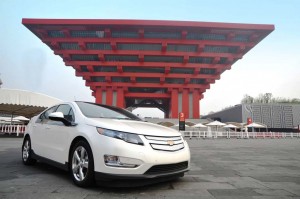
The Chevrolet Volt in China. The Chevy and Cadillac brands will now serve as GM's lead global marques.
General Motors is working on a dual-brand emphasis that will put Chevrolet and Cadillac in the position of lead brands as the maker presses forward with its global expansion, according to GM chairman and chief executive Dan Akerson.
The move relegates brands like Buick and GMC to regional responsibilities, but it also appears to downgrade the role of Opel, the German-based subsidiary that had long been GM’s lead brand outside North America.
“Creating a global dual-brand strategy with Cadillac and Chevrolet, flanked by regional brands in places like China, Australia and Europe,” is one of the challenges facing General Motors, Akerson said during GM’s first stockholders meeting in Detroit since 1990.
Brands such as Opel, Holden and Buick will have supporting roles, said Akerson, who also told reporters he would like to see Cadillac built in other parts of the world as part of the dual brand strategy. Insiders say there’s a good likelihood that could result in a Cadillac model coming off one of GM’s assembly lines in China, where it is now the largest automaker, with a 15% share of the booming market.
Arch-rival Toyota uses a similar two-brand strategy, with its Toyota and Lexus marques, noted Akerson, who stressed that Chevrolet is one of the best-known automotive brands in the world.
Chevrolet has clearly been gaining ground in its global roll-out. While it remains a relatively niche brand in Europe, it has nonetheless become the fastest-growing marque in an otherwise stagnant Continental market. It is gaining ground in China, as well, a region where GM initially launched with the Buick brand.
Chevy is also gaining ground in Latin America, the one overseas market where it has long had a presence (For more on Chevrolet’s growth in Latin American markets, Click Here.)
Until recently, GM had considered Opel its global brand. But Opel has been losing ground for much of the past decade, and continues to rack up serious losses in the European market, despite repeated turnaround plans. GM is yet again cautiously promising to get the brand back in the black this year.
Following GM’s emergence from Chapter 11, the maker gave serious thought to selling off a controlling stake in Opel in return for a bailout from Germany and other European governments. In the end, a deal with supplier Magna collapsed, but company insiders say the experience led GM’s new management team to diminish Opel’s overall role in the corporate brand hierarchy.
GM also is carefully looking at other challenges that could dump roadblocks onto its path, including tighter fuel economy regulations that could require a complete overhaul of GM’s full-size pickup trucks and sport utility vehicles.
“Last year we prepared a detailed plan to address the possibility of oil going to $120/barrel,” Akerson said. “We’ve created an integrated risk function, a Chief Risk Officer and staff to analyze our vulnerabilities and proactively address them
“Reviewing our design, engineering and manufacturing footprints, reducing complexities and eliminating costs,” Akerson said, “are the kinds of things you would expect of any smart business. But we are pursuing larger goals at GM, too that will position us for long term success.”
GM’s ongoing overhaul also includes mixing the passion and expertise of long-term employees with some fresh, outside perspective and by attracting talent from competitors inside the auto industry, as well. Akerson is the second CEO in a row to be recruited from outside the auto industry. Like his predecessor, Ed Whitacre, the current chief executive previously worked in the telecommunications industry. Meanwhile, this week, GM hired another senior manager with an AT&T pedigree to head its vast Human Resources operations.
The strategy is paying off, the executive told shareholders, hoping to downplay concerns about GM stock, which is off about 15% since the maker’s November 2010 IPO.
“The products we have, and the competitive dynamic we now have, are generating results that we can build on for the future,” Akerson said. “We’ve had five straight profitable quarters… and that’s largely because we’re competitive now. We’re gaining market share — 11.5% global share in the first quarter of 2011, up nearly half a point year over year,” Akerson said.
Akerson acknowledged GM faces plenty of challenges, but he insisted the company was better-positioned to handle them than it has been in decades.
“As perverse as it may sound, the bankruptcy may be seen in the future not only as a second chance but a rebirth as a 21st century global manufacturing company no longer burdened by the past,” he proclaimed.
Paul A. Eisenstein contributed to this report.
